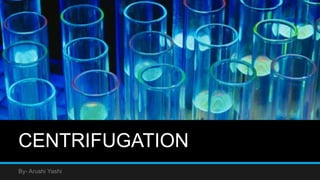
Centrifugation Techniques Explained
- 2. CONTENTS • Definition • Introduction • Principle • Working • Types of Centrifugation • Applications
- 3. DEFINITION Centrifugation is a process used to separate or concentrate materials suspended in a liquid medium. The theoretical basis of this technique is the effect of gravity on particles (including macromolecules) in suspension. Two particles of different masses will settle in a tube at different rates in response to gravity.
- 4. INTRODUCTION • Centrifugation is a process which involves the use of the centrifugal force for the sedimentation of heterogeneous mixtures with a centrifuge, used in industry and in laboratory settings. • This process is used to separate two immiscible liquids. • More-dense components of the mixture migrate away from the axis of the centrifuge, while less dense components of the mixture migrate towards the axis.
- 5. PRINCIPLE • A centrifuge is a device for separating particles from a solution according to their size, shape, density, viscosity of the medium and rotor speed. • In a solution, particles whose density is higher than that of the solvent sink (sediment), and particles that are lighter than it float to the top. • The greater the difference in density, the faster they move. If there is no difference in density (isopycnic conditions), the particles stay steady. • To take advantage of even tiny differences in density to separate various particles in a solution, gravity can be replaced with the much more powerful “centrifugal force” provided by a centrifuge.
- 6. WORKING • A centrifuge is a piece of equipment that puts an object in rotation around a fixed axis (spins it in a circle), applying a potentially strong force perpendicular to the axis of spin (outward). • The centrifuge works using the sedimentation principle, where the centripetal acceleration causes denser substances and particles to move outward in the radial direction. • At the same time, objects that are less dense are displaced and move to the center. In a laboratory centrifuge that uses sample tubes, the radial acceleration causes denser particles to settle to the bottom of the tube, while low density substances rise to the top.
- 7. TYPES OF CENTRIFUGATION • 1. Density gradient centrifugation. • 2. Differential centrifugation. • 3. Ultra centrifugation.
- 8. 1. DENSITY GRADIENT CENTRIFUGATION • It allow separation of many or all components in a mixture and allows for measurement to be made. There are two forms of Density gradient centrifugation : • a) Rate zonal centrifugation. • b) Isopycnic or sedimentation equilibrium centrifugation.
- 9. RATE ZONAL CENTRIFUGATION • In Rate zonal centrifugation the solution have a density gradient. The sample has a density i.e. greater than all the layers in the solution. • The sample is applied in a thin zone at the top of the centrifuge tube on a density gradient. Under centrifugal force, the particles will begin sedimenting through the gradient. • The particles will begin sedimenting in separate zones according to their size shape and density.
- 10. ISOPYCNIC OR SEDIMENTING EQUILIRIBIUM CENTRIFUGATION • In this type of centrifugation , the solution contains a greater range of densities. • The density gradient contains the whole range of densities of the particles in the sample. • Each particle will sediment only to the position in the centrifuge tube at which the gradient density is equal to its own density. • In Isopycnic centrifugation separation of particles occurs into zones on the basis of their density differences, independent of time.
- 11. 2. DIFFRENTIAL CENTRIFUGATION • Differential centrifugation is a common procedure in microbiology and cytology used to separate certain organelles from whole cells for further analysis of specific parts of cells. • In the process, a tissue sample is first homogenized to break the cell membranes and mix up the cell contents. • The homogenate is then subjected to repeated centrifugations, each time removing the pellet and increasing the centrifugal force.
- 12. 3. ULTRA CENTRIFUGATION • It is invented by Theodor Svedberg in 1923, for which he was awarded Noble prize in 1926. • It is an important tool in biochemical research. It imposes high centrifugal force on suspended particles and separates them on the basis of difference in molecular weight. • For example: - RBC are separated from plasma or blood - Nuclei from mitochondria - One protein from another complex mixture - Isolation of DNA, RNA and lipids • Its rotational speed is up to 80000 rpm. • It create a centrifugal force up to 600000g
- 13. APPLICATIONAS • Separation of two miscible substances • Purification of mammalian cells • Fractionation of subcellular organelles (including membranes/membrane fractions) Fractionation of membrane vesicles • Removing fat from milk to produce skimmed milk • Separating particles from an air-flow using cyclonic separation • Separation of urine components and blood components in forensic and research laboratories • Aids in the separation of proteins using purification techniques such as salting out, e.g. ammonium sulfate precipitation.
Editor's Notes
- Summarize your research in three to five points.
